The AMD Radeon R9 Fury X Review: Aiming For the Top
by Ryan Smith on July 2, 2015 11:15 AM ESTCompute
Shifting gears, we have our look at compute performance. As an FP64 card, the R9 Fury X only offers the bare minimum FP64 performance for a GCN product, so we won’t see anything great here. On the other hand with a theoretical FP32 performance of 8.6 TFLOPs, AMD could really clean house on our more regular FP32 workloads.
Starting us off for our look at compute is LuxMark3.0, the latest version of the official benchmark of LuxRender 2.0. LuxRender’s GPU-accelerated rendering mode is an OpenCL based ray tracer that forms a part of the larger LuxRender suite. Ray tracing has become a stronghold for GPUs in recent years as ray tracing maps well to GPU pipelines, allowing artists to render scenes much more quickly than with CPUs alone.
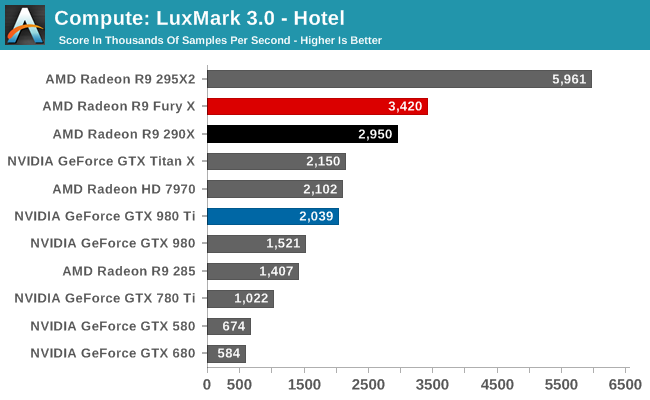
The results with LuxMark ended up being quite a bit of a surprise, and not for a good reason. Compute workloads are shader workloads, and these are workloads that should best illustrate the performance improvements of R9 Fury X over R9 290X. And yet while the R9 Fury X is the fastest single GPU AMD card, it’s only some 16% faster, a far cry from the 50%+ that it should be able to attain.
Right now I have no reason to doubt that the R9 Fury X is capable of utilizing all of its shaders. It just can’t do so very well with LuxMark. Given the fact that the R9 Fury X is first and foremost a gaming card, and OpenCL 1.x traction continues to be low, I am wondering whether we’re seeing a lack of OpenCL driver optimizations for Fiji.
For our second set of compute benchmarks we have CompuBench 1.5, the successor to CLBenchmark. CompuBench offers a wide array of different practical compute workloads, and we’ve decided to focus on face detection, optical flow modeling, and particle simulations.
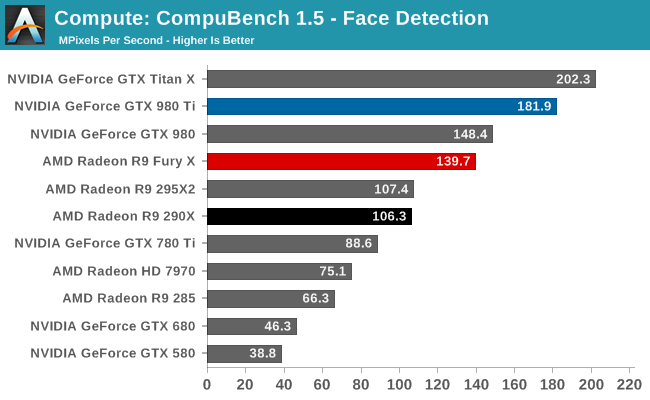
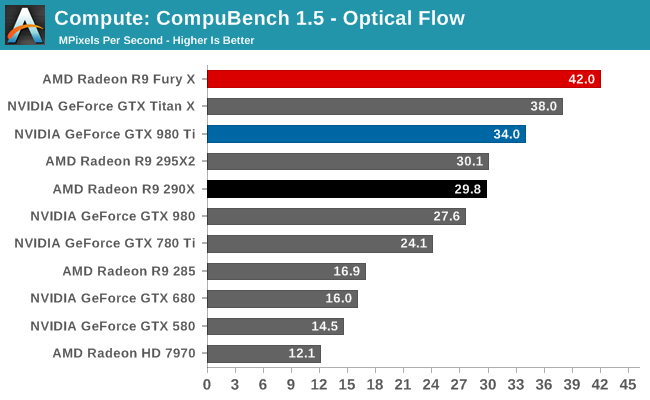

Quickly taking some of the air out of our driver theory, the R9 Fury X’s performance on CompuBench is quite a bit better, and much closer to what we’d expect given the hardware of the R9 Fury X. The Fury X only wins overall at Optical Flow, a somewhat memory-bandwidth heavy test that to no surprise favors AMD’s HBM additions, but otherwise the performance gains across all of these tests are 40-50%. Overall then the outcome over who wins is heavily test dependent, though this is nothing new.
Our 3rd compute benchmark is Sony Vegas Pro 13, an OpenGL and OpenCL video editing and authoring package. Vegas can use GPUs in a few different ways, the primary uses being to accelerate the video effects and compositing process itself, and in the video encoding step. With video encoding being increasingly offloaded to dedicated DSPs these days we’re focusing on the editing and compositing process, rendering to a low CPU overhead format (XDCAM EX). This specific test comes from Sony, and measures how long it takes to render a video.
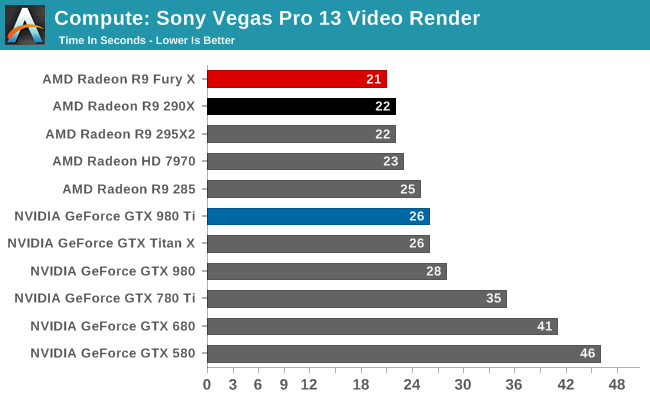
At this point Vegas is becoming increasingly CPU-bound and will be due for replacement. The Fury X none the less shaves off an additional second of rendering time, bringing it down to 21 seconds.
Moving on, our 4th compute benchmark is FAHBench, the official Folding @ Home benchmark. Folding @ Home is the popular Stanford-backed research and distributed computing initiative that has work distributed to millions of volunteer computers over the internet, each of which is responsible for a tiny slice of a protein folding simulation. FAHBench can test both single precision and double precision floating point performance, with single precision being the most useful metric for most consumer cards due to their low double precision performance. Each precision has two modes, explicit and implicit, the difference being whether water atoms are included in the simulation, which adds quite a bit of work and overhead. This is another OpenCL test, utilizing the OpenCL path for FAHCore 17.
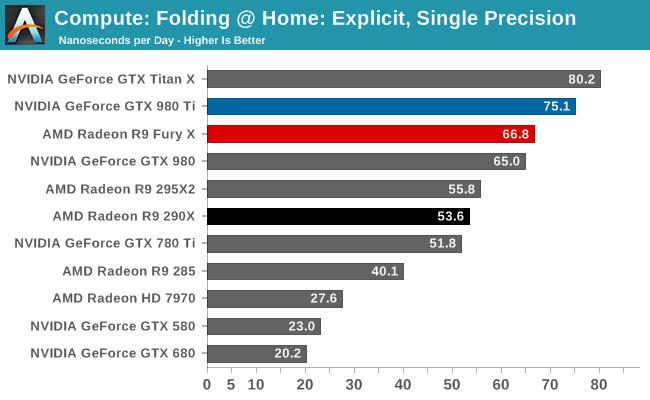

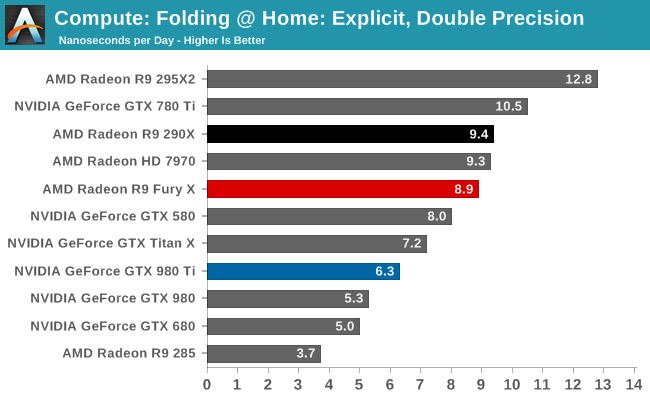
Both of the FP32 tests for FAHBench show smaller than expected performance gains given the fact that the R9 Fury X has such a significant increase in compute resources and memory bandwidth. 25% and 34% respectively are still decent gains, but they’re smaller gains than anything we saw on CompuBench. This does lend a bit more support to our theory about driver optimizations, though FAHBench has not always scaled well with compute resources to begin with.
Meanwhile FP64 performance dives as expected. With a 1/16 rate it’s not nearly as bad as the GTX 900 series, but even the Radeon HD 7970 is beating the R9 Fury X here.
Wrapping things up, our final compute benchmark is an in-house project developed by our very own Dr. Ian Cutress. SystemCompute is our first C++ AMP benchmark, utilizing Microsoft’s simple C++ extensions to allow the easy use of GPU computing in C++ programs. SystemCompute in turn is a collection of benchmarks for several different fundamental compute algorithms, with the final score represented in points. DirectCompute is the compute backend for C++ AMP on Windows, so this forms our other DirectCompute test.
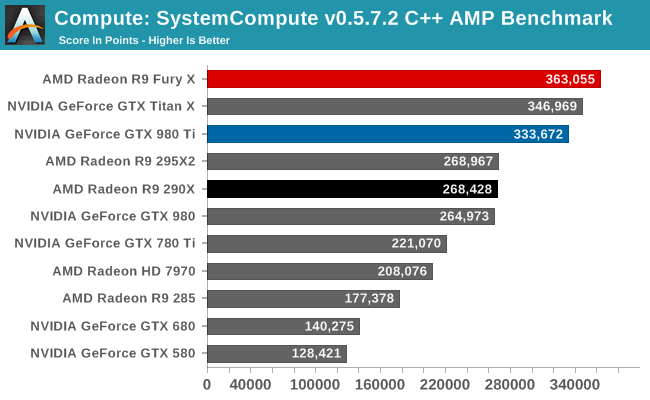
Our C++ AMP benchmark is another case of decent, though not amazing, GPU compute performance gains. The R9 Fury X picks up 35% over the R9 290X. And in fact this is enough to vault it over NVIDIA’s cards to retake the top spot here, though not by a great amount.










458 Comments
View All Comments
Chaser - Friday, July 3, 2015 - link
Oh yeah that invalidated the entire review. /facepalmStrychn9ne - Saturday, July 4, 2015 - link
Great review here! It was a good read going through all the technical details of the card I must say. The Fury X is an awesome card for sure. I am trying to wait for next gen to buy a new card as my 280X is holding it's own for now, but this thing makes it tempting not to wait. As for the performance, I expect it will perform better with the next driver release. The performance is more than fine even now despite the few losses it had in the benches. I suspect that AMD kind of rushed the driver out for this thing and didn't get enough time to polish it fully. The scaling down to lower resolutions kind of points that way for me anyways.Peichen - Saturday, July 4, 2015 - link
AMD/ATI, what a fail. Over the past 15 years I have only gone Nvidia twice for 6600GT and 9800GT but now I am using a GTX 980. Not a single mid-range/high-end card in AMD/ATI's line up is correctly priced. Lower price by 15-20% to take into account the power usage, poor driver and less features will make them more competitivejust4U - Saturday, July 4, 2015 - link
At the high end you "may" have a point.. but what is the 960 bringing to the table against the 380? Not much.. not much at all. How about the 970 vs the 390? Again.. not much.. and in crossfire/sli situations the 390 (in theory..) should be one helluva bang for the buck 4k setup.There will be a market for the FuryX.. and considering the efforts they put into it I don't believe it's going to get the 15-20% price drop your hoping for.
TheinsanegamerN - Saturday, July 4, 2015 - link
Slightly better performance while pulling less power and putting out less heat, and in the 970's case, is currently about $10 cheaper. Given that crossfire is less reliable than SLI, why WOULD you buy an AMD card?Oxford Guy - Saturday, July 4, 2015 - link
Maybe because people want decent performance above 3.5 GB of VRAM? Or they don't appreciate bait and switch, being lied to (ROP count, VRAM speed, nothing about the partitioning in the specs, cache size).medi03 - Sunday, July 5, 2015 - link
Freesync?Built-in water cooling?
Disgust for nVidia's shitty buisness practices?
A brain?
chizow - Monday, July 6, 2015 - link
How do you feel about the business practice of sending out a card with faults that you claimed were fixed?Or claims that you had the world's fastest GPU enabled by HBM?
Or claims/benches that your card was faster than 980Ti?
Or claims that your card was an Overclocker's Dream when it is anything but that and OCs 10% max?
A brain right? :)
sa365 - Tuesday, July 7, 2015 - link
How do you feel about the business practice of sending out a card with faulty, cheating drivers that lower IQ despite what you set in game so you can win/cheat in those said benchmarks. It's supposed to be apples to apples not apples to mandarins?How about we wait until unwinder writes the software for voltage unlocks before we test overclocking, those darn fruits again huh?
Nvidia will cheat their way through anything it seems.
It's pretty damning when you look at screens side by side, no AF Nvidia.
Margalus - Monday, July 6, 2015 - link
freesync? not as good as gsync and is still not free. It takes similar hardware added to the monitor just like gsync.built in water cooling? just something else to go wrong and be more expensive to repair, with the possibility of it ruining other computer components.
Disgust for NVidia's shitty business practices? what are those? Do you mean like not giving review samples of your cards to honest review sites because they told the truth about their cards so now you are afraid that they will tell the truth about your newest pos? Sounds like you should really hate AMD's shitty business practices.